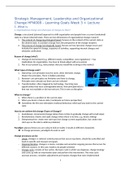Strategic Management, Leadership and Organizational
Change HPI4008 – Learning Goals Week 3 + Lecture
1. What is
a. Organizational change and what types of change are there?
Change: a structured (planned) approach to shift organization and people from a current (undesired)
state to a future (desired) state. There are two dimensions of organizational change research:
1. The content of change/psychological based: focuses on the content of the current state vs
the desired state. It considers change from the perspective of the change recipient.
2. The process of change/sociologically based: focuses on how (process) change occurs and
includes the speed of change, sequence of activities, supporting internal changes and
obstacles confronted.
Reason of change (why?):
1. Change of environment (e.g. different needs, competition, new regulations) -> has
implications for organization. You have to timely adjust with eco-system
2. Flux in eco-system (e.g. new product that you would like to bring to the market)
What types of change exist?
1. Improving: core principles stay the same, other elements change.
Master the principles. There is hidden potential.
2. Renewal: core principles are limitation and have to change.
Principles were already out there and are selected
3. Transformation: often triggered by technology. You bring new
opportunities that were unimaginable before. New principle kicks in
that was not available or did not exist yet. This is seen as disruptive
When to change?
1. When there is a problem in the current state
2. When you desire a future state (=anticipate on future perspective)
Sometimes the first one stimulates irrational behaviour which pull you back to the current
state
How do we achieve this change (Types of Change)?
1. Evolutionary: incremental change (when there is time to gradually change with small steps)
2. Revolutionary: drastic and rapid change (when there is no time, e.g. titanic sinking)
3. Entrepreneurism: create new start-ups (not change current organization, but create new
start-ups on the side to address problems)
Paradigm: glasses/lenses you are using to look at reality (=results in different viewpoint).
In change processes, paradigms do exist as well
Change processes can be:
- Linear: change is a rational, orderly process that occurs top-down, should be controlled and
leads to specific and measure end goals
- Ongoing/Iterative: change is a messy, complex and uncertain ongoing process that occurs for
different reasons. In this case, leaders are people-oriented
- Change cycle: consists of two cycles; the basic cycle in which you diagnose, change strategy
and come up with an intervention plan and perform the intervention. The meta cycle
assesses process, considers adjustments and replans changes that were implemented
1
, There are 3 paradigms in change processes (change approaches):
1. The Lewin’s 3 stage model (classic view) exists
2. (Post-) modern view
3. Ambidexterity approach
Assumptions between these views differ
Lewin’s 3 stage model (Classical view):
1. Unfreeze: first you will create awareness and reduce resistance in order to introduce change
2. Change: subsequently you introduce new concepts, practices etc
3. Refreeze: finally you will re-stabilize the organization and include new concepts and practices
into daily routines within the organization. This step secures the change
Assumptions in classical view:
o Change is shifting from one static state to another
o Change is an exception, stability is the rule
o Change is a rational, technical process (‘’try to avoid making mistakes’’)
Post-Modern View: characterized by continued flow of changes
1. Present state
2. Flux (energy)
3. Next state
Assumptions in post-modern view:
o Change is dynamic (goes on)
o Change is permanent (Heraclitus)
o Change is complex (outcome is not certain, ‘’making mistakes is part of learning process’’)
o Change is technical, social and political (e.g. willingness, ability and interest)
Most organizations are still in classical view and are moving towards post-modern view. However, in
the context of post-modern view it is often observed that change processes are used. This may not
be so smart to do so.
b. Change capabilities (When can we consider an organization capable of (or ready for) change?)?
Organizational capacity for change (OCC): a dynamic organizational capability that allows the
enterprise to adapt old capabilities to new threats and opportunities as well as create new
capabilities (Judge and Elenkov, 2005). This will create new organizational capabilities
-Change capabilities are especially relevant in uncertain environments
8 Key dimensions of organizational change key into four organizational polarities=
(1) a leader and follower polarity;
(2) an innovation and accountability polarity;
(3) a unitary and distributed leadership polarity; and
(4) a thinking and action polarity.
This OCC consists of: (readiness to change/Judge & Blocker)
1. Contextual factors – (e.g. organizational context like policies and procedures, and past
experiences etc.), this influences the:
- Change valance → Collective change commitment – motivation theory: the more organizational
members that value the chance, the more likely implementation is
- Informational assessment (on task demands, resource availability, situational factors) → Collective
change efficacy – social cognitive theory: whether it is believed the organization is capable in terms
2





